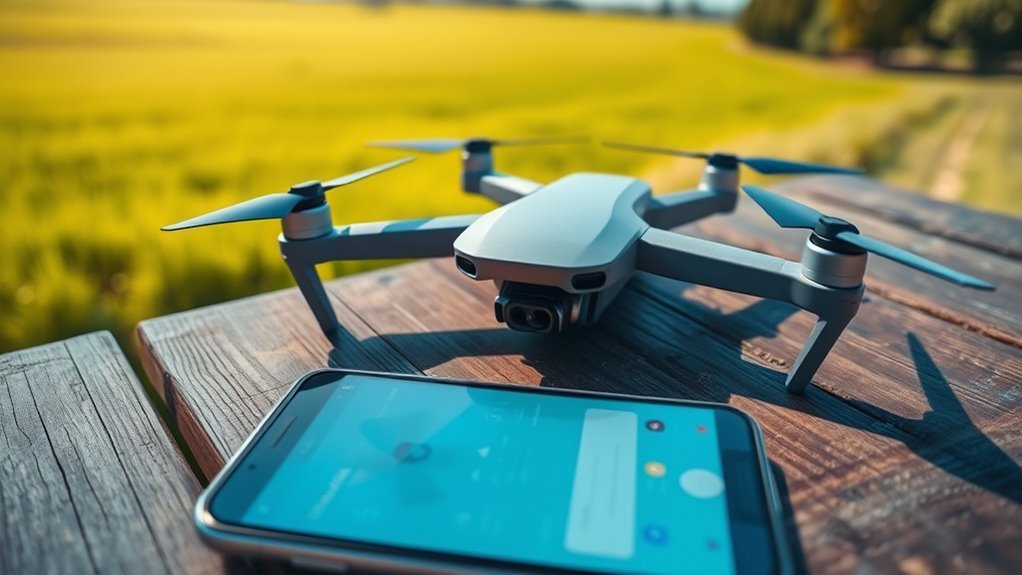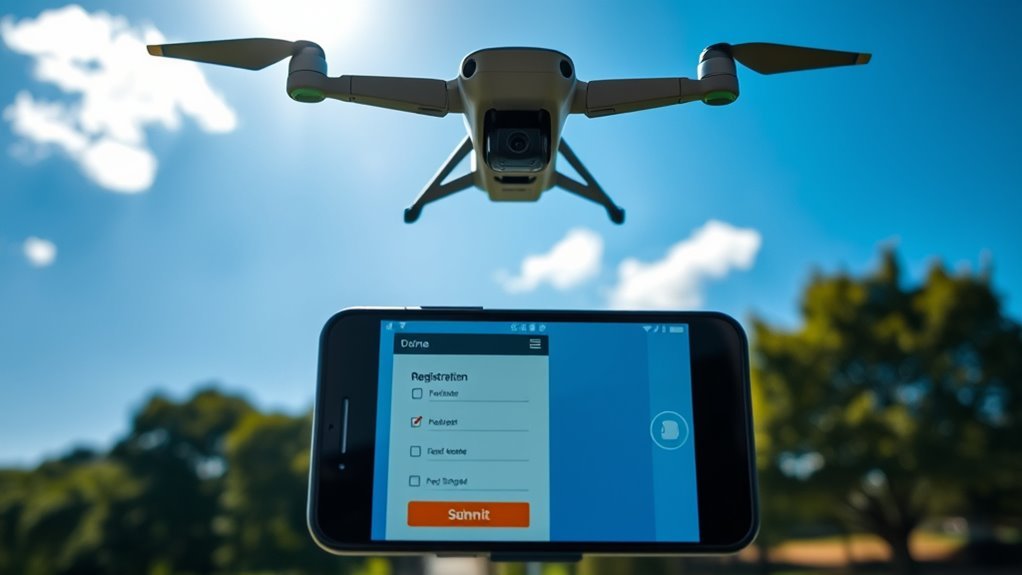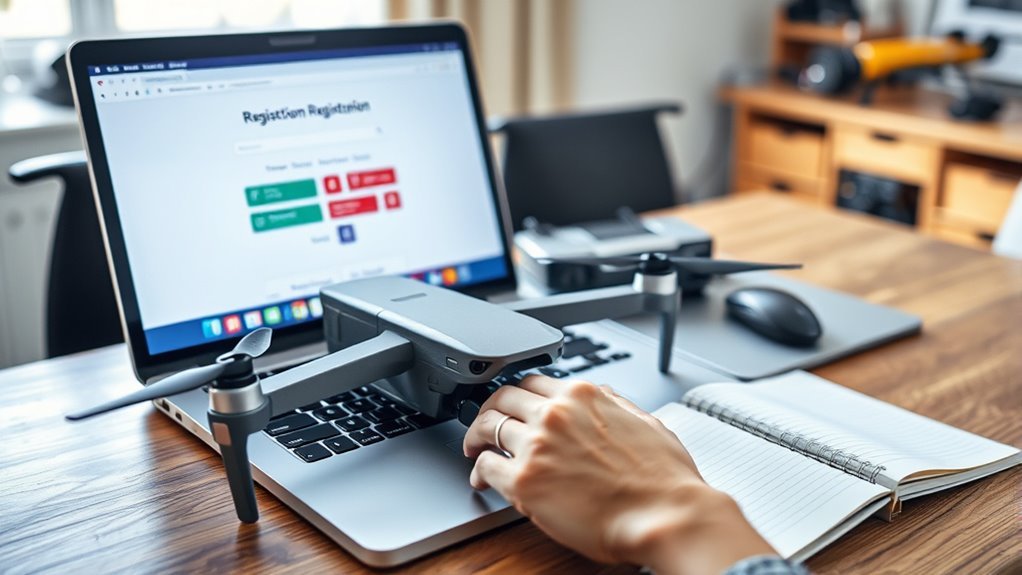To register your drone, first, verify it weighs over 0.55 pounds. You’ll need to gather necessary documents like identification and your drone’s serial number. Create an account on the FAA’s registration portal, fill out the registration form, and pay the $5 fee. After submission, you’ll receive a registration certificate via email. Don’t forget to keep your registration information updated to avoid penalties. For more details on each step, keep exploring the process.
Understanding Drone Registration Requirements

When you’re planning to fly a drone, understanding the registration requirements is vital to guarantee compliance with regulations. Registering your drone isn’t just a bureaucratic step; it plays a significant role in drone safety and helps mitigate potential legal implications. In the U.S., for instance, the Federal Aviation Administration (FAA) mandates that drones weighing over 0.55 pounds must be registered. This process includes providing your information and paying a nominal fee. Failure to register can lead to hefty fines and restrict your freedom to operate your drone. By adhering to these requirements, you guarantee not only your safety but also the safety of others, paving the way for responsible drone use in shared airspace.
Determining the Type of Drone You Own

How do you know what type of drone you own? Understanding the different drone types and weight categories is essential for registration and usage. Here’s how to determine your drone’s classification:
Knowing your drone type is crucial for proper registration and adherence to regulations.
- Camera Drones: Designed for aerial photography and videography.
- Racing Drones: Built for speed and agility, often used in competitive racing.
- Toy Drones: Lightweight and designed for recreational use, typically under 0.55 lbs.
- Commercial Drones: Heavier drones used for business purposes, often exceeding 55 lbs.
- Fixed-Wing Drones: Have wings like an airplane, suited for long-distance flights.
Identifying the type of drone you own not only helps in registration but also guarantees you comply with regulations governing its use.
Preparing the Necessary Documentation

Once you’ve identified the type of drone you own, the next step involves gathering the necessary documentation for registration. Proper document preparation is essential to guarantee a smooth registration process. You’ll need to collect required forms, including proof of ownership and any necessary identification, such as your driver’s license or passport. It’s important to check the specific regulations in your area, as these can vary. Make certain to have your drone’s serial number and specifications on hand, as these details will be required on the forms. Double-check that everything is complete and accurate to avoid delays. By preparing your documentation diligently, you can streamline your registration and enjoy the freedom to fly your drone responsibly.
Navigating the Registration Process Online
Are you ready to tackle the online registration process for your drone? Steering through the registration portal can be straightforward if you keep a few online application tips in mind. Here’s what to focus on:
- Create an account: Sign up on the registration portal before starting your application.
- Gather your info: Have your drone’s make, model, and serial number handy.
- Understand fees: Be aware of any registration fees to avoid surprises.
- Follow prompts: Carefully read and follow the on-screen instructions for each step.
- Review before submitting: Double-check your entries to verify accuracy.
Completing the Registration Form
When completing the registration form for your drone, you’ll need to provide specific details such as your contact information and the drone’s characteristics. The online registration process is straightforward, guiding you through each required section. Don’t forget to include the registration fee payment to finalize your submission.
Required Information Details
To successfully complete the drone registration form, you’ll need to gather specific information that guarantees compliance with regulatory requirements. This information not only confirms you’re following the rules but also contributes to a smooth registration timeline. Here’s what you’ll typically need:
- Your name and contact information
- A valid address
- Drone specifications, including make and model
- The weight of your drone
- Any previous registration details, if applicable
Having this information ready will streamline the registration process, letting you hit the skies sooner. Remember, accurately filling out the form is vital for avoiding delays and potential issues later on. So, get organized, and prepare to release your drone’s full potential responsibly!
Online Registration Process
Now that you’ve gathered the necessary information for your drone registration, it’s time to complete the online registration form. This step is vital for ensuring drone safety and opening registration benefits that come with flying responsibly. The form will ask for details such as your contact information and drone specifications.
| What You’ll Gain | Why It Matters |
|---|---|
| Legal Flying Rights | Freedom to explore the skies |
| Access to Resources | Knowledge for safer operations |
| Community Support | Connect with fellow enthusiasts |
Filling out the form accurately is essential. Once completed, you’ll have peace of mind knowing you’re compliant with regulations, paving the way for a fulfilling aerial adventure while contributing to overall drone safety.
Registration Fee Payment
Once you’ve completed the online registration form, the next step involves submitting your registration fee. Understanding the registration fee structure is vital for a smooth process. Here’s what you need to know:
- The fee is typically a one-time payment.
- Various payment methods are accepted, including credit cards and online wallets.
- Make certain to double-check the amount before confirming.
- After payment, you’ll receive a payment confirmation, which is essential for your records.
- Keep this confirmation handy, as it may be required for future reference.
Completing the payment confirmation process guarantees your drone registration is official, allowing you the freedom to fly your drone legally. So, take a moment to finalize this step for hassle-free flying!
Paying the Registration Fees
Once you’ve completed the registration form, you’ll need to address the registration fees, which typically amount to $5 for a three-year period. You can pay these fees using various methods, including credit cards and electronic payment systems. Understanding the payment options available can streamline the registration process for your drone.
Registration Fee Amount
When registering your drone, you’ll encounter a registration fee that is vital for compliance with aviation regulations. Understanding the drone registration costs can help you budget effectively. Typically, the fee is around $5, but it’s important to confirm current amounts as they may vary. Here are some key points about the registration fee:
- It’s a one-time payment valid for three years.
- You can register multiple drones under the same account.
- The fee supports the upkeep of airspace safety.
- Make sure you provide accurate information to avoid additional fees.
- Keep your payment confirmation for future reference.
Exploring your fee payment options can also streamline the registration process, guaranteeing you’re ready to take to the skies responsibly.
Payment Methods Available
Before you proceed with your drone registration, it’s crucial to know the various payment methods available for the registration fees. The most common option is using credit card options, which allow for a quick and secure transaction online. Most registration platforms accept major cards like Visa, MasterCard, and American Express, guaranteeing convenience. If you’d prefer not to use a credit card, there are alternative payment methods available, such as PayPal or bank transfers. These options provide flexibility, catering to your preferences. Remember, regardless of the method, verify your payment is processed successfully to avoid delays in your registration. With the right payment method, you can swiftly move forward and enjoy the freedom of flying your drone.
Receiving Your Registration Certificate
After submitting your drone registration, you’ll receive a registration certificate, which is essential for legal operation. The registration certificate delivery typically occurs via email, so keep an eye on your inbox. This certificate has a validity duration of three years, after which you’ll need to renew your registration.
Here’s what to expect with your certificate:
- A unique registration number for your drone
- Proof of compliance with FAA regulations
- Important for insurance and liability claims
- Required when flying in controlled airspace
- Must be accessible during flight operations
Make certain to print a copy and keep it with you while flying. This guarantees you can demonstrate your legal right to operate your drone freely and responsibly.
Keeping Your Registration Information Updated
Receiving your registration certificate is just the first step in guaranteeing compliance with FAA regulations. To maintain your freedom to fly, it’s essential to keep your registration information updated. If your address, ownership, or contact details change, you must notify the FAA within 30 days. This isn’t just a bureaucratic requirement; it’s about maintaining accuracy in your records and making sure you can be reached if necessary. You can easily update your information through the FAA’s online portal, which streamlines the process. Regularly review your registration details to verify everything is current. By staying vigilant about updating information, you protect your rights as a drone operator and reduce the risk of potential penalties.
Understanding the Consequences of Non-Registration
Failing to register your drone can lead to serious consequences that extend beyond mere fines. Not only are you risking legal penalties, but you may also face safety risks and compliance issues that could jeopardize your freedom to fly. Consider the following potential repercussions:
- Legal penalties: Fines can be hefty, impacting your finances.
- Safety risks: Unregistered drones may cause accidents, putting others at risk.
- Compliance issues: You might not be able to fly in certain areas legally.
- Enforcement actions: Authorities may confiscate your drone if you’re caught unregistered.
- Insurance problems: Lack of registration could void any insurance coverage you have.
Stay informed and compliant to guarantee your flying experience remains safe and enjoyable.
Frequently Asked Questions
Can I Register My Drone if I Live Outside the U.S.?
Yes, you can register your drone internationally, but it depends on the foreign regulations in your country. Each nation has its own requirements, so be sure to check local laws to verify compliance.
What Happens if I Lose My Registration Certificate?
If you lose your registration certificate, don’t worry—over 1.5 million drones are registered in the U.S. You can easily start the registration process again online and explore replacement options through the FAA’s website.
Is There an Age Limit for Registering a Drone?
There’re specific age requirements for the registration process; you must be at least 13 years old to register a drone. Verify you meet this criteria to enjoy the freedom of flying your drone legally.
Can I Register Multiple Drones Under One Account?
Yes, you can register multiple drones under one account, simplifying account management. Think of it as a digital hangar, where all your flying machines are stored together, ready for your adventures in the skies.
How Often Do I Need to Renew My Drone Registration?
You need to renew your drone registration every three years. The renewal process guarantees your information remains current, allowing for continued flight freedom. Keep track of your registration duration to avoid any penalties or issues.

